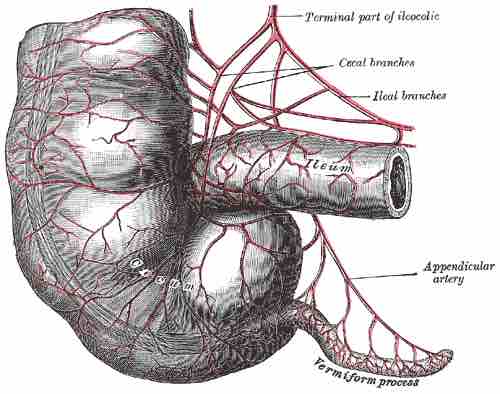What Are Vestigial Structures?
Some organisms possess structures with no apparent function which appear to be residual parts from a past ancestor. For example, some snakes have pelvic bones despite having no legs because they descended from reptiles that did have legs. Another example of a structure with no function is the human vermiform appendix. These unused structures without function are called vestigial structures. Other examples of vestigial structures are wings (which may have other functions) on flightless birds like the ostrich, leaves on some cacti, traces of pelvic bones in whales, and the sightless eyes of cave animals.

Vestigial appendix
In humans the vermiform appendix is a vestigial structure; it has lost much of its ancestral function.
There are also several reflexes and behaviors that are considered to be vestigial. The formation of goose bumps in humans under stress is a vestigial reflex its function in human ancestors was to raise the body's hair, making the ancestor appear larger and scaring off predators. The arrector pili muscle, which is a band of smooth muscle that connects the hair follicle to connective tissue, contracts and creates the goose bumps on skin.
Vestigial Structures in Evolution
Vestigial structures are often homologous to structures that function normally in other species. Therefore, vestigial structures can be considered evidence for evolution, the process by which beneficial heritable traits arise in populations over an extended period of time. The existence of vestigial traits can be attributed to changes in the environment and behavior patterns of the organism in question. As the function of the trait is no longer beneficial for survival, the likelihood that future offspring will inherit the "normal" form of it decreases. In some cases the structure becomes detrimental to the organism.

Whale Skeleton
The pelvic bones in whales are also a good example of vestigial evolution (whales evolved from four-legged land mammals and secondarily lost their hind legs). Letter c in the picture indicates the undeveloped hind legs of a baleen whale.
If there are no selection pressures actively lowering the fitness of the individual, the trait will persist in future generations unless the trait is eliminated through genetic drift or other random events.
Although in many cases the vestigial structure is of no direct harm, all structures require extra energy in terms of development, maintenance, and weight and are also a risk in terms of disease (e.g., infection, cancer). This provides some selective pressure for the removal of parts that do not contribute to an organism's fitness, but a structure that is not directly harmful will take longer to be 'phased out' than one that is. Some vestigial structures persist due to limitations in development, such that complete loss of the structure could not occur without major alterations of the organism's developmental pattern, and such alterations would likely produce numerous negative side-effects.
The vestigial versions of a structure can be compared to the original version of the structure in other species in order to determine the homology of the structure. Homologous structures indicate common ancestry with those organisms that have a functional version of the structure. Vestigial traits can still be considered adaptations because an adaptation is often defined as a trait that has been favored by natural selection. Adaptations, therefore, need not be adaptive, as long as they were at some point.